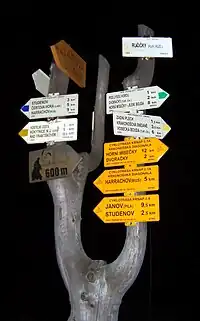Krkonoše/Karkonosze Transboundary Biosphere Reserve
The Krkonoše/Karkonosze Transboundary Biosphere Reserve (Czech: [ˈkr̩konoʃɛ] ⓘ, Polish: [karkɔˈnɔʂɛ]) is a MAB transboundary biosphere reserve, mixed mountain and highland system designated by UNESCO as Krkonoše/Karkonosze Mountains in 1992. It is shared by the Czech Republic and Poland.[1] Notably, it is one of only two successful transboundary management structures in existence, aside from the East Carpathians Biosphere Reserve, due to contrasting goals in other shared areas covered by MAB.[2]
| Krkonoše/Karkonosze Transboundary Biosphere Reserve[1] | |
|---|---|
 Map of the central Krkonoše/Karkonosze | |
| Type | Biosphere Reserve |
| Location | Czech Republic / Poland |
| Area | 60,362 hectares (149,157.75 acres) |
| Created | 1992 |
| Operated by | Biosphere Reserve Bilateral Board |
| Website | http://www.unesco.org/new/en/natural-sciences/environment/ecological-sciences/biosphere-reserves/europe-north-america/czech-reppoland/krkonosekarkonosze/ |
Land cover characterization


The Krkonoše/Karkonosze ecosystem is managed by the Biosphere Reserve Bilateral Board composed of Czech-Polish specialists,[1] with financial aid from the Global Environment Facility (GEF).[3] It is an ecological island, noted by UNESCO for its profusion of mountain meadows with a network of chalets, and a significant infrastructure both for winter-and-summer sports, as well as qualified tourism.[4]
The landscape relief on the Polish side of the biosphere reserve differs from the Czech part considerably. It is very steep and therefore lacking in human development, but instead, it is covered by dense forests. However, both Polish and Czech mountains are equally impacted by heavy air pollution. The Giant Mountains are frequented by over 10 million visitors annually, mostly hikers and skiers, with about 6–8 million in the Czech Republic and 2,5–3 million on the Polish side of the system as of 2002.[4]
Environment
The Krkonoše/Karkonosze biosphere reserve programme is run by nine Czech-Polish working groups,[1] each focusing on a separate topic area, including nature conservation, tourism, forestry management, and local communities among other things. Their Bilateral Board provides a forum for cross-border communication regarding legal matters as well as development plans and scientific research. The sun-drenched southern slopes differ from the northern slopes also in their habitat although both consist basically of alpine tundra vegetation with subarctic peat bogs and spruce forests. The network administration is shared between Krkonoše National Park and Karkonosze National Park authorities,[1] with headquarters in Vrchlabí and Jelenia Góra respectively.
References
- "Krkonoše/Karkonosze Transboundary Biosphere Reserve, Czech Republic/Poland". United Nations Educational, Scientific and Cultural Organization. Retrieved 2023-08-03.
- Urami Manage Goodale (2003). A Transboundary Management Plan. p. 98. ISBN 1560220953. Retrieved 2013-01-15.
The establishment of a permanent common structure has been achieved in only two cases: the Krkonose/Karkonosze Biosphere Reserve [and] the East Carpathians Biosphere Reserve... All other sites rely exclusively on personal contacts... (Juliet J. Fall)
{{cite book}}:|work=ignored (help) - World Conservation Congress (1998). Krkonose/Karkonosze (in) Transfrontier Biosphere Reserves as models for management of shared ecosystems. ISBN 2831704553. Retrieved 2013-01-15.
{{cite book}}:|work=ignored (help) - "The Krkonoše / Karkonosze Transboundary Biosphere Reserve (BRKK)" (PDF). UNESCO Biosphere Reserve on the Czech-Polish boundary. The United Nations Educational, Scientific and Culture Organization. 2011. p. 36. Archived from the original (PDF file, direct download 2.00 MB) on 2015-05-01. Retrieved 2013-01-15.
External links
- Detailed map, Poland (2012). "Krkonose/Karkonosze UNESCO-MAB Biosphere Reserve". Protected Planet. ProtectedPlanet.net. Retrieved 2020-06-07.